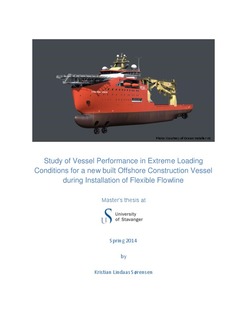| dc.contributor.author | Lindaas Sørensen, Kristian | |
| dc.date.accessioned | 2015-01-14T12:29:29Z | |
| dc.date.available | 2015-01-14T12:29:29Z | |
| dc.date.issued | 2014-06-16 | |
| dc.identifier.uri | http://hdl.handle.net/11250/274073 | |
| dc.description | Master's thesis in Offshore Technology | nb_NO |
| dc.description.abstract | A new built vessel need to carry out extensive sea trials before being put in what could be considered as “normal operation”. This is done to make sure the capabilities of the vessel are known to the vessel’s crew, captain, client and other interested parties before any real operations takes place.
Prior to the sea trials one may have some knowledge about how the vessel will behave. This is generally based on experience of ship designers, captain, as well as experience from somewhat similar vessels (e.g. sister ships), if available. Model tests are also important, and used to confirm various parameters. In addition preliminary hydrodynamic analyses can be of great advantage.
This is the starting point for my master thesis in “Marine and Subsea Technology” at the University of Stavanger. The focus has been to carry out a study investigating vessel performance/capabilities and motion characteristics for mainly two extreme loading conditions for Solstad Offshore ASA’s new built, Offshore Subsea Construction Vessel (OSCV) To Be Named (TBN) “Normand Vision”. This ship is to be long term chartered by Ocean Installer AS. The study is based on an installation operation of a flexible flowline in the North Sea at 350 meters water depth. The motivation is to learn the vessel’s performance/capacities when working under different loading conditions and sea states based on available knowledge and data.
To investigate this, a dynamic analysis was carried out with use of the popular hydrodynamic analysis software “OrcaFlex”, with help of Microsoft Excel for making of scripts and processing of results. A number of environmental parameters and data regarding the vessel and the flowline were used in order to get a somewhat precise analysis. Wave heights, directions and periods were determined and a suitable wave model was chosen.
Relevant limits and criteria for various operational aspects were defined according to product data, standards/regulations, certification requirements and other relevant literature. The maximum/minimum values for the different parameters were of interest as these covers the whole range of outcomes one could expect.
The results from the analysis showed to be quite OK for the smallest waves and head seas. The analysis also revealed that the larger waves and more unfavourable wave headings gave more divergent results and challenges for certain parameters. The results for the various parameters and sea states are outlined and discussed. The different parameters are presented with the limits that apply for the actual parameter.
In addition some spot checking with some more recently defined loading conditions was carried out. Also some highlights especially with respect to roll motions, and landing of helicopters on monohull vessels were looked into. | nb_NO |
| dc.language.iso | eng | nb_NO |
| dc.publisher | University of Stavanger, Norway | nb_NO |
| dc.relation.ispartofseries | Masteroppgave/UIS-TN-IKM/2014; | |
| dc.rights | Attribution 3.0 Norway | * |
| dc.rights.uri | http://creativecommons.org/licenses/by/3.0/no/ | * |
| dc.subject | offshore construction vessel | nb_NO |
| dc.subject | OrcaFlex | nb_NO |
| dc.subject | dynamic analysis | nb_NO |
| dc.subject | vessel motions | nb_NO |
| dc.subject | RAO | nb_NO |
| dc.subject | parametric roll resonance | nb_NO |
| dc.subject | flexible flowline | nb_NO |
| dc.subject | helideck | nb_NO |
| dc.subject | North Sea conditions | nb_NO |
| dc.subject | offshore teknologi | nb_NO |
| dc.subject | undervannsteknologi | nb_NO |
| dc.title | Study of vessel performance in extreme loading conditions for a new built offshore construction vessel during installation of flexible flowline | nb_NO |
| dc.type | Master thesis | nb_NO |
| dc.subject.nsi | VDP::Technology: 500::Marine technology: 580::Offshore technology: 581 | nb_NO |

